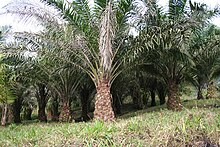African Oil Palm
| African oil palm | |
|---|---|
 |
|
| African oil palm (Elaeis guineensis) | |
| Scientific classification | |
| Kingdom: | Plantae |
| Family: | Arecaceae |
| Subfamily: | Arecoideae |
| Tribe: | Cocoeae |
| Genus: | Elaeis |
| Species: | E. guineensis |
| Binomial name | |
|
Elaeis guineensis Jacq. |
|
| Synonyms | |
Elaeis guineensis is a species of palm commonly called African oil palm or macaw-fat. It is the principal source of palm oil. It is native to west and southwest Africa, specifically the area between Angola and the Gambia; the species name guineensis refers to the name for the area, Guinea, and not the modern country which now bears that name. The species is also now naturalised in Madagascar, Sri Lanka, Malaysia, Sumatra, Central America, the West Indies and several islands in the Indian and Pacific Oceans. The closely related American oil palm Elaeis oleifera and a more distantly related palm, Attalea maripa, are also used to produce palm oil.
Human use of oil palms may date as far back as 5,000 years in West Africa; in the late 1800s, archaeologists discovered palm oil in a tomb at Abydos dating back to 3,000 BCE. It is thought that Arab traders brought the oil palm to Egypt.
The first western person to describe it and bring back seeds was the French naturalist Michel Adanson.
Mature palms are single-stemmed and grow to 20 m tall. The leaves are pinnate and reach between 3-5 m long. A young palm produces about 30 leaves a year. Established palms over 10 years produce about 20 leaves a year. The flowers are produced in dense clusters; each individual flower is small, with three sepals and three petals.
...
Wikipedia
